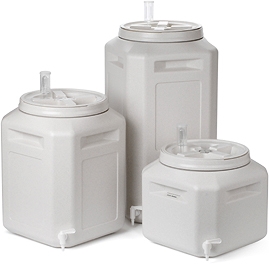 Hi Kraus,
Hi Kraus,
I am using the 14 gal tuff-tank for the primary fermentation and like it. My questions are can you also use the 14 gal tuff-tanks and other similar plastic fermenters for the second stage fermentation instead of glass carboys and Is there pros’s and con’s?
I thank you for your great service, JL.
__________
Dear JL,
The only thing you need to be concerned about when using our Tuff-Tanks or any other plastic fermenter in a secondary fermentation situation is head-space. This is the area between the surface of the wine must and the fermenter’s lid.
Air can be a spoiler of wine. If the air exposure is excessive, it can allow mold to grow on the wine’s surface, and it can also cause the wine to brown or oxidize. These are thing that don’t happen overnight, but if enough time is given, they can occur. For these reasons, head-space is always an area of concern.
The good news is air exposure and its effects are of little issue while the wine is still fermenting in a plastic fermenter. During the fermentation, CO2 gas is being given off which protects the wine must from air.
What this means for the winemaker is that during the primary fermentation, there is so much protective gas coming off that you don’t even need a lid on the plastic fermenter. Just a thin towel or similar will work fine. And, during the secondary fermentation, having head-space is okay as well, just as long as a fermentation of some sort is still occurring.
After the fermentation has stopped, or the air-lock has stopped bubbling, the head-space is still okay, so long as you do not remove the lid from the plastic fermenter. This is because the head-space is filled with CO2 gas, not air, at that point. The gas is heavier than air, so it does not want to escape from the plastic fermenter. It wants to stay as a protective blanket over the wine.
However, once the lid has been removed after the fermentation is complete, all bets are off. Something will have to be done at that point, whether it be transferring the wine from the plastic fermenter into carboys for aging, or just going ahead and bottling the wine.
JL, I hope this information clears things up for you. If there is still something you don’t understand, please contact us so we can discuss it further.
Happy Wine Making
Customer Service
———————————————————————————————————
Ed Kraus is a 3rd generation home brewer/winemaker and has been an owner of E. C. Kraus since 1999. He has been helping individuals make better wine and beer for over 25 years.
